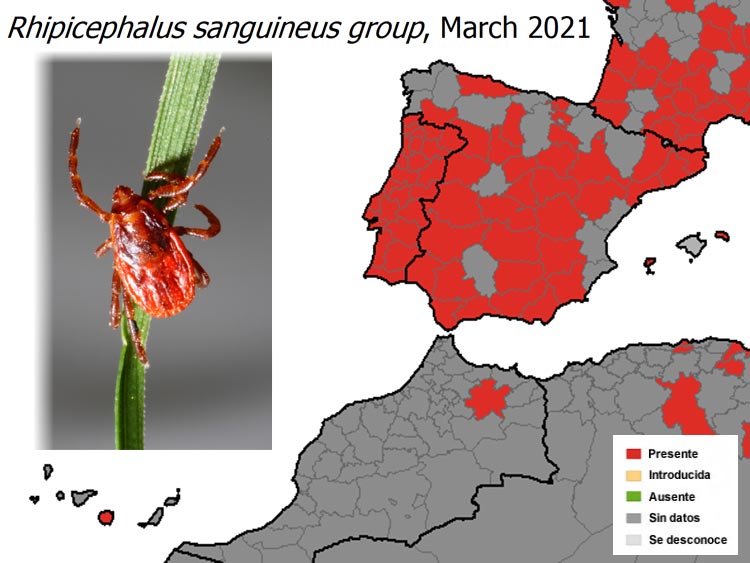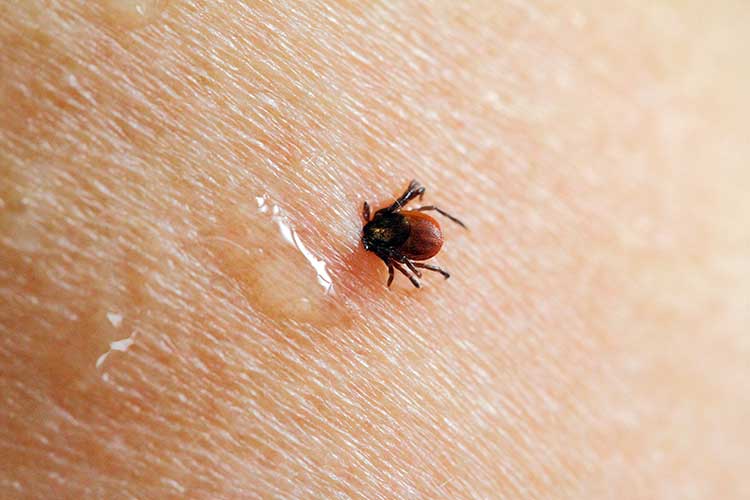We all know that going out into nature to practice our favorite sport or to take a pleasant walk is not risk-free. We are very clear that we must plan and prepare the route we are going to take to minimize those risks and enjoy the activity. We also know that in nature we are going to meet the plants and animals that inhabit it, but do we know that some of them, however small they may be, can put us in real trouble? That's why today I want to talk about ticks, a danger for hikers and mountaineers.

Many of you will surely relate these arachnids, yes arachnids not insects, with pets, farm animals and wild animals, and in a way you are right, but humans are also among their preferences. Likewise we usually relate the presence of ticks with farms and stables in towns or villages, but nowadays we can also find real tick infestations in our cities.
I have been hiking and mountaineering for many years, years in which I have gradually come across more and more cases of tick bites and I have noticed that it is increasingly common to see them waiting for one of their victims clinging to a plant or bush. Surely we know someone who has been bitten by a tick and most probably nothing has happened to him/her, beyond the annoying bite.
The first reason is that when we remove it, we leave part of the tick inside the skin, causing an infection, so, as we will see below, removing it correctly has its own technique.
The second is the serious diseases they can transmit, some of which are fatal and which unfortunately are becoming more common than we might think.

There are different genera with their respective species of ticks, each with its own particularities. From their first phase of growth they are parasites that feed on blood, that is to say since they are larvae of only 0.5 mm of size they can bite us, although being so young we are surely their first victim and it will be more difficult for them to transmit us any pathogen, another thing are the nymphs and the adult ticks. Let's see the species that, as of today, we can find in Spain.
This tick is autochthonous and survives in diverse environmental conditions. It can be found practically all over the peninsula, although it needs a high degree of humidity. Among the diseases it can transmit is the not inconsiderable Lyme borreliosis, which is "characterized" by the red and white circles surrounding the tick bite.
This arachnid is characterized by taking advantage of migratory birds to extend its domain, it also supports more extreme conditions so we can find it in arid areas and marshes. This tick is one of the main responsible for transmitting the Crimean-Gongo hemorrhagic fever virus, together with Dermacentor reticulatus and Rhipicephalus bursa, with some cases already in Spain..

This sister of the previous one is also very capable of transmitting the same terrible diseases as the other one. For now its presence is not as widespread as Marginatum but it is gaining ground with each passing year.
This tick is more present in the southwest area of the peninsula and can cause recurrent fevers even if a larva bites us, since the pathogens that cause them can be transmitted from the tick to its larvae. The species Carios Erraticus is the tick that most likes to bite humans, there have been cases of transmission of African swine fever to humans in Spain and Portugal transmitted by this species of tick, luckily it usually prefers areas where hygienic conditions are not the best.
It is more common in the north of the peninsula, as well as in the rest of the European continent, as it likes cold climates. They tend to prefer cattle and dogs to humans, but in the absence of bread...

Perhaps the most common of all of them worldwide within the genus of Rhipicephalus, it does like relatively warm climates and is also often accompanied by pathogens that can put us in trouble.
Ticks need animals to feed, so it is common to find them in areas frequented by livestock and wild animals, although as we have already seen, it is not so rare to see them in city parks.
We may think that by not approaching animals and not touching them we are safe, but nothing could be further from the truth. Ticks are patient bugs, they do not fly so they wait for their hosts attached to the bushes, to the grass on the ground or to the leaves of the trees, to simply climb on our clothes or on our skin when we rub against the plant where they are waiting for us. It is therefore important to follow a series of tips before, during and after the activity.

Clothes are your first barrier, and if possible in light colors to be able to see the bug scurrying around. I know that nowadays asking you to go out in nature with long pants, t-shirt with long sleeves tucked into your pants and a cap that covers your hair is a difficult task, and I'm not saying anything if I also ask you to wear your socks over your trouser leg as spats, but if you are going to be in areas with cattle or thick vegetation, don't hesitate. This rare outfit can save you from tick bites and other bugs, skin problems from rubbing against stinging plants or sunburn.
Use repellents, preferably with a high degree of DEET in their composition. These products can help us to prevent the tick from getting on us, you have to spray them on the exposed areas of the legs and arms. Likewise, if you wear long pants and long sleeve shirts, spray the product on the areas that are more in contact with bushes, weeds, etc...

Try to avoid passing through areas of tall grass and bushes; ticks wait for their host by clinging to the tops of plants.
Walk along the center of the path, away from the bushes and weeds, so you can see where you are stepping.
Do not touch livestock or wild animals, it is usually not a good idea even if they do not have ticks.
Try to sit on rocks, avoiding the fields where the cattle graze, we are all tempted by the green meadows surrounded by mountains on the banks of the river.
Check from time to time that you are not transporting any unwanted stowaways.
Ticks inoculate a powerful "anesthetic" in the area of the bite to prevent you from noticing it, so it is very important that we check our whole body for ticks, just as we do with our pet.
Bring clothes to change into once you finish the activity, so you avoid putting the bug in the car.
Put your clothes in a closed bag so that if you are carrying a tick it does not escape, you can also apply specific insecticide for arachnids.
Check your whole body well, they usually like warm and hidden areas, English, armpits, back of the knees and between the toes as well as the head.
Remember that your backpack, apart from carrying your things, is also a means of transport for various bugs. Do not put it on the bed or the area where you sleep, when you are on the road try not to leave it lying anywhere and when you get home, before cleaning it, you can spray it with insecticide.

First of all, do not get nervous and do not panic, as we have already mentioned, it is usual that nothing happens, although it is true that every day there are more cases with greater consequences, even among famous athletes. It is important to follow a series of steps that we detail below.
Of course it is essential to remove it as soon as possible, the longer it is there, the more chances of infection we have. But we can not do it in any way we need specific tweezers that can be found in any pharmacy and that every hiker should carry in your kit. In case you don't have them or you don't know how to use them, go to your doctor and ask him to do it. It is important not to leave parts of the tick inside our skin to avoid infections.
It goes without saying that once extracted, the wound must be disinfected and checked to make sure that nothing has been left inside.
After removal it is important to keep the tick for at least 4 weeks, in a closed container and in a cool place, although in some places they advise to keep it even up to 2 months. The reason is very simple, in case of medical complications, the tick will provide a lot of information about the type of pathogen that is causing the complications.
In case we have symptoms such as fever for no apparent reason, muscle weakness, strange spots on the skin, headaches, joint or muscle pain within four weeks after the bite, we should go to the doctor urgently and tell him/her that we have been bitten by a tick.

It is not uncommon that we are bitten by a tick and it detaches itself without us realizing it, we must know that if the tick is infected it will transmit the infection at the same moment of the bite, regardless of the time it is in our body. Besides, the symptoms of the diseases transmitted by ticks are very similar to those of other diseases and can make it difficult for the medical service to diagnose them correctly.
More information at ECDC
As we already know, when we go out in nature we are not exempt from risks, but we can mitigate them as much as possible and this case is no exception.
There is no need to be alarmed, but neither should the diseases they can transmit be taken as a joke, since they can cause serious health problems and even death.
Remember, enjoy nature and its landscapes respecting it, taking care of it and being aware that it is not an amusement park.
We would be grateful if you could write to us to inform us of any erroneous or outdated information you have found, or simply to let us know what you think at Thank you very much.